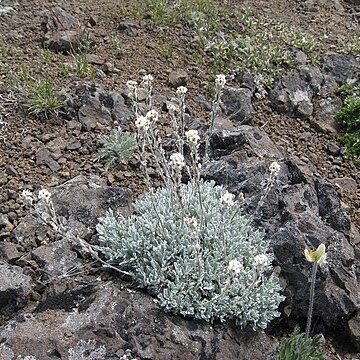Plants cespitose, caudex well-developed, thick, often-branched, covered with persistent petiolar remains; not scapose; usually pubescent. Stems erect to decumbent, unbranched or branched distally, densely pubescent. Leaves basal and cauline; petiolate or sessile; basal rosulate, petiolate, blade margins usually 1-or 2-pinnatisect, rarely entire. Racemes (corymbose, several-flowered), often considerably elongated in fruit. Fruiting pedicels ascending, spreading, suberect, or divaricate [recurved], slender. Flowers: sepals (sometimes persistent), oblong [ovate]; petals spatulate to obovate or suborbicular, (longer than sepals), claw differentiated from blade, (apex rounded); stamens slightly tetradynamous; filaments often dilated basally; anthers ovate or oblong, (apex obtuse); nectar glands usually confluent, subtending bases of stamens, median glands present or not. Fruits siliques or silicles, usually sessile, rarely shortly stipitate, linear, oblong, obovoid, ellipsoid, spatulate, oblanceolate, suboblong, or pyriform [fusiform, ovoid, suborbicular], smooth, 4-angled, angustiseptate, terete, or subterete [latiseptate]; valves each with prominent or obscure midvein, usually glabrous; replum rounded; septum complete or perforated; ovules 4-18 per ovary; stigma capitate. Seeds plump, not winged, usually oblong, rarely oblong-lanceolate; seed coat (minutely reticulate), not mucilaginous when wetted; cotyledons incumbent or accumbent.
More
Herbs perennial, often pulvinate, with well-developed caudex covered with petioles of previous years. Trichomes dendritic, sometimes mixed with simple and forked stalked ones. Stems erect or ascending, several from caudex, simple or branched apically. Basal leaves petiolate, rosulate, simple, 1-or rarely 2-pinnatisect, sometimes entire, densely pubescent. Cauline leaves shortly petiolate or sessile, not auriculate, entire or pinnatisect. Racemes ebracteate or basally bracteate, elongated in fruit. Fruiting pedicels suberect, ascending, or divaricate. Sepals ovate or oblong, ascending or spreading, base of lateral pair not saccate. Petals white, creamy white, or purplish, longer than sepals; blade suborbicular, obovate, or spatulate, apex rounded; claw subequaling or longer than sepals. Stamens 6, tetradynamous; filaments dilated at base; anthers ovate or oblong, obtuse at apex. Nectar glands confluent and subtending bases of all stamens. Ovules 6-30 per ovary. Fruit dehiscent siliques or silicles, linear, oblong, ovoid, obovoid, ellipsoid, or lanceolate, terete or slightly 4-angled, sometimes angustiseptate; valves with a prominent midvein, smooth; replum rounded; septum complete or perforated; style absent or short and to 1.5 mm; stigma capitate, entire. Seeds uniseriate, wingless, oblong, plump; seed coat minutely reticulate, not mucilaginous when wetted; cotyledons incumbent.

